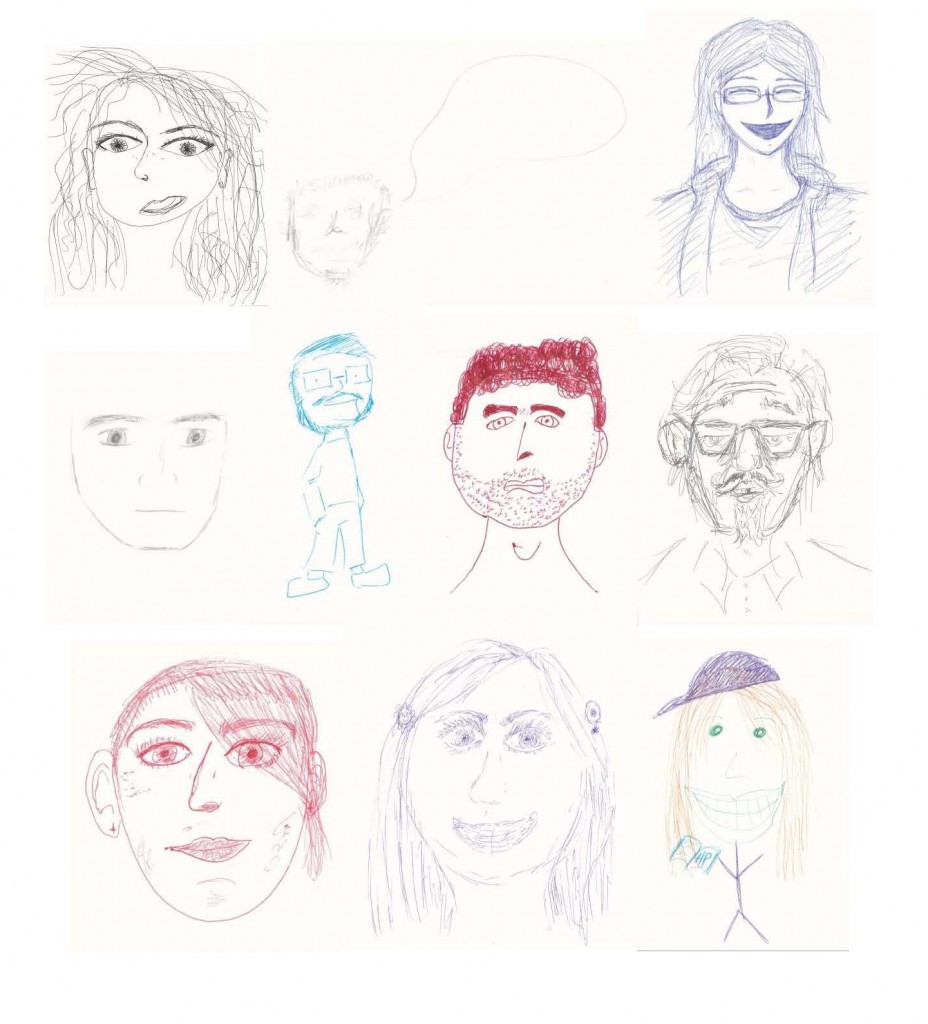
Here are our self-portraits that we did without looking in the mirror. Dear Sigmund, what do these tell us? Better yet, we need an art therapist…
When I did the strange-face-in-the-mirror illusion, I turned into a frickin’ werewolf! How cool is that? I should back up, right? I teach a course called “Primate Religion & Human Consciousness” & require students to come up with activities to help us experience the readings. The readings this week were the first chapter from Julian Keenan’s book The Face in the Mirror, which synopsizes Gordon Gallup’s mirror self-recognition research & Julian’s studies of the neural correlates of self- & other-recognition (& has a hilarious passage about interviewing with Gordon for grad school in a gym & having their discussion about his graduate aspirations while buck-naked in the shower), & Oliver Sacks’ classic “The Man Who Mistook His Wife for a Hat.” The Sacks piece outlines a case of visual agnosia.
The objective of the activities is to “embody” the readings–i.e., to do an activity inspired by, related to, or actually discussed in the readings. We did two activities. Well, three, really. The first was the class itself. I booked us into a studio with a wall of mirrors in the Student Recreation Center so we’d have to stare at ourselves the entire class & reflect on reflecting. That was fun (I wish I’d remembered to take a photo). We played Ramachandran-inspired games (replicating phantom limb therapy by typing with one hand in the mirror so it looked like we were doing it with two) & generally made ourselves uncomfortable. Then, Lizzie Ernstburger had us turn away from the mirror & draw ourselves as we “see” ourselves. The idea is that we have a sense of ourselves from years of looking in mirrors but also a sense of how we see ourselves appearing to others based on how we feel about ourselves.
Then, Annie Lenox brought in a 2010 article in Perception by Giovanni B. Caputo called “Strange-face-in-the-mirror illusion.” You may be familiar with this as a kids’ game called Bloody Mary or some variation, but I wasn’t so bear with me. You go into a darkened room with a mirror, light a candle, & stare into your own eyes for two minutes. The flickering candlelight will mess with your visual perceptivity, & your face will start to do crazy things. My feature detectors went bonkers, & everything on my face started moving around, then at one point the outlines around my eyebrows, mustache, goatee, & sideburns vanished, & it looked like hair had grown all over my face like a werewolf! So cool!
Lots of implications here, but I am reminded of Mel Konner’s 1985 piece called “Transcendental Medication,” in which he suggests that one of the reasons ritual behavior among the !Kung probably takes place at night is because the firelight becomes so hypnotic in the dark & fascilitates the altered states of consciousness that are part & parcel of possession culture (actually, it may just be implied in Konner’s essay, but also told me this personally when he visited Bama a few years ago to given an ALLELE lecture called “Childhood Evolving”). Michael Winkelman has probably addressed this as well, but it would go a long way toward explaining why shamanistic rituals & spirit journeys often feature transformations into animals or human-animal mutating, whether or not psychopharmacological substances are involved.
